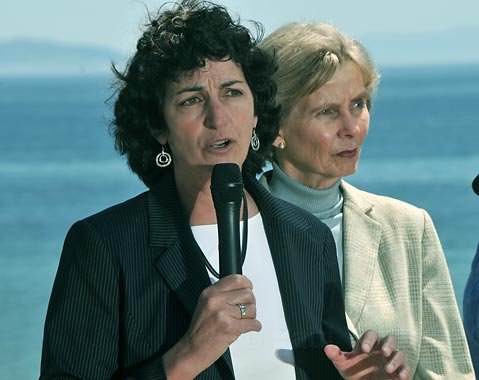Rigs to Reef or Rigs to Grief?
Debate Over Fate of Existing Offshore Oil Rigs Comes to Santa Barbara

As it stands, the 27 oil rigs thumping and pumping off the coast of California — 20 of which call the Santa Barbara Channel home — must someday be removed by the oil companies that put them there. An enormously physical and fiscally taxing undertaking, the full removal of the massive structures is one of the conditions of the longstanding leases that allow the companies to mine the black gold. But if a State Assembly bill currently trying to earn approval in Sacramento passes, rig operators would be able to apply for a waiver on this condition and potentially leave portions of the rigs in the Pacific Ocean forever, all in the name of ocean habitat enhancement.

Controversial since the idea was first floated nearly two decades ago, the most recent “Rigs to Reef” proposal, as it’s commonly known, looms large this week in Santa Barbara as California’s Ocean Protection Council (OPC) hosts a hearing today, June 25, that features a presentation and panel discussion of a recently released Rigs to Reef study. Fresh off the presses, the 263-page report is already causing a stir in the environmental community. “It is a nightmare,” said the Environmental Defense Center’s Linda Krop, who is scheduled to speak on a related panel this afternoon. “It is incomplete, misstates the law, and even misrepresents the issues.”
Created in 2004 as part of the California Ocean Protection Act, the OPC is a seven-member board of state officials and two public citizens who are charged with defending the ocean’s health, coordinating the various state agencies with ocean-minded jurisdictions, and examining potential changes to state legislation. In 2007, the California Natural Resources Agency (CNRA) began an official investigation into the various options facing offshore oil rigs come decommissioning time; the goal was “to assemble and examine scientific and legal information that will frame future state policy discussion on the alternatives for decommissioned platforms.”

In a private-public partnership that’s an increasingly preferred arrangement in Sacramento for environmental investigations, the nonprofit Ocean Science Trust began spearheading the project. Funded by a mix of government and private funding — including the OPC, The Ocean Conservancy, United Anglers, the Sportfishing Conservancy, and the Chevron Corporation — the trust spent nearly three years soliciting questions and then, with the help of a consulting firm, providing answers about full, partial, and no removal of the rigs. The resulting, presumably unbiased document was released in its final form on June 8, but gets its first public dissection on Friday afternoon inside the Santa Barbara County administration building.
According to the report, a majority of the 27 rigs off the coast of California will reach a decommissioning point sometime between 2015 and 2030. Many see this as a chance to rid the ocean once and for all of these rigs while others — citing data that shows how marine ecosystems have evolved around the rigs’ underwater infrastructure — see decommissioning as an opportunity to preserve this unintended but seemingly positive side-effect of oil drilling by letting portions of the rigs to remain. Meanwhile, everyone is also focused on the drastic difference in price to the oil companies between the options: full removal is estimated to cost upwards of $1.1 billion while partial removal could save operators roughly $616 million. The report’s intent was to cover the pros and cons and provide a thoughtful framework by which legislators can examine the issue. However, just how well the report succeeds in those goals remains to be seen.

“When this started, we were led to believe they would study unanswered questions, but instead what they did was synthesize existing information, leaving large and pre-existing data gaps,” said Krop, who worked on rig decommissioning projects off of Summerland in the mid-1990s. “At this point it seems like it was a big waste of money.” Specifically, the gaps — which are acknowledged in the report — include rather fundamental areas of debate, such as the actual importance of rigs as habitat, economic impacts associated with removing versus letting rigs stay, impacts on recreational and commercial fishermen, permitting issues, and costs.
Krop’s not alone in her concerns about the report. In the run-up to today’s meeting, several experts who served on the report’s 15-member advisory committee have expressed frustration with not having their concerns and suggestions properly reflected, and some haven’t even been given the chance to read the final report yet. That includes Doug Anthony, director of the county’s energy division, who could not comment on the merits of the report, but did say that the committee suggested “significant revisions” on early drafts of the report and explained that comments on the second draft were only turned in on April 22. “I can’t say whether those are actually in the final report because I just haven’t had it long enough,” said Anthony, who will be speaking on a panel with Krop today. “I mean, I don’t even have a hard copy yet. But I hope and assume that they would be.”
Foreseeing a less-than-ideal end to the report by mid-March, Krop said that the EDC requested that a draft report be released before it was finalized, that a hearing be held to allow for public comment, and that a section be added to the report to detail the advisory committee’s concerns. None of that happened, but as Krop explained, “At least the first real presentation will be here in Santa Barbara and the public will be able to sit in and comment if they like.”
That goes down today, Friday, June 25, in the room 406 of the Santa Barbara County administration building’s executive office. The meeting starts at 9:30 a.m., but the Rigs to Reef presentation won’t commence until after talks about ocean acidification and a report on lessons learned by the Marine Life Management Act.



